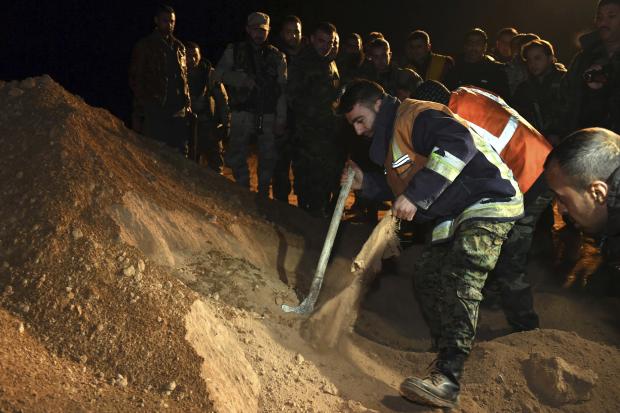
In this file photo released early Saturday, Dec. 30, 2017, by the Syrian official news agency SANA, Syrian security force members work at the site of two mass graves believed to contain the bodies of civilians and troops killed by the Islamic State militants, in the village of Wawi near the northern city of Raqqa, Syria. (Photo from SANA via AP)
BEIRUT — Activists working to uncover mass graves in northeastern Syria – a region until recently controlled by the Islamic State group — need help to preserve evidence, identify human remains and shed more light on the unspeakable horrors perpetrated by the militants during their reign there, an international watchdog said Tuesday.
Human Rights Watch said thousands of bodies – both of civilian victims brutally slain by the extremists and of IS fighters themselves – remain to be recovered in several mass graves scattered around the city of Raqqa and nearby areas. According to remnants of clothing on them, some of the bodies already found are thought to be of IS militants.
The appeal came in a new report released Tuesday by the New York-based group.
Local members of the Raqqa Civil Council are “struggling to cope with the logistical challenges of collecting and organizing information” on the bodies uncovered and providing it to families searching for missing or dead relatives, HRW said.
Raqqa was the extremists’ de facto capital and the seat of their self-proclaimed caliphate – from which IS ruled the territories it controlled – lands that at the height of the militants’ power in 2014 amounted to a third of both Syria and Iraq.
The caliphate and the contiguous territory under IS crumbled in October last year.
The extremist group, which attracted fighters from around the world, ruled the area with a mix of terror, fear and brutality. It carried out atrocities and mass killings, often in public beheadings, burning, drowning or blowing up victims who were strapped with explosives beforehand.
Women and men under IS rule who were accused of adultery were stoned to death, while gay men were thrown from the tops of buildings, their crushed bodies subsequently pounded with stones.
US-backed Syrian Kurdish-led fighters and Syrian government forces have captured most of the once IS-controlled lands in Syria and the extremists are now squeezed in small patches, scattered across the country’s east.
In neighboring Iraq, government forces, backed by the US-led coalition and Shiite-led militias, announced the full defeat of IS shortly after capturing the militants’ stronghold of Mosul last year, Iraq’s second-largest city.
Human Rights Watch underscored that identifying missing people and preserving evidence for possible prosecutions is critical for Syria’s future.
“Raqqa city has at least nine mass graves, each one estimated to have dozens, if not hundreds, of bodies, making exhumations a monumental task,” said Priyanka Motaparthy, acting emergencies director at HRW.
“Without the right technical assistance, these exhumations may not provide families with the answers they have been waiting for and could damage or destroy evidence crucial to future justice efforts,” she added.
In its report, HRW said that on June 12, the first responders’ team in Raqqa finished uncovering one mass grave containing of 553 bodies and reburying them in a local graveyard after logging in their identifying information.
It added that the team subsequently began work uncovering a second mass grave.
The first grave, at the city’s al-Rashid playing field, is one of nine mass grave locations the activist team has identified, HRW quoted a local team leader as saying. The report added that HRW researchers visited the site in May.
The Syrian team operates under the authority of the Raqqa Civil Council, a local governance unit created by the opposition Syrian Democratic Council in April 2017.
In 2016, when IS was losing territories it held, The Associated Press documented and mapped 72 of the mass graves in Iraq and Syria with many more expected to be uncovered.
In Syria, the AP obtained locations for 17 mass graves, including one with the bodies of hundreds of members of a single tribe all but exterminated when IS extremists took over their region. For at least 16 of the Iraqi graves, most in territory too dangerous to excavate, officials do not even guess the number of dead.
In others, estimates are based on memories of traumatized survivors, Islamic State group’s propaganda and what can be gleaned from a cursory look at the earth.
At the time, between 5,200 people to more than 15,000 people were believed buried in the graves.